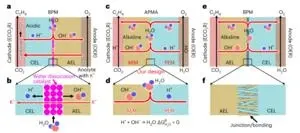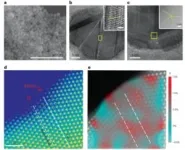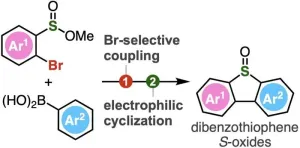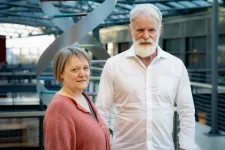(Press-News.org) Global warming continues to pose a threat to human society and the ecological systems, and carbon dioxide accounts for the largest proportion of the greenhouse gases that dominate climate warming. To combat climate change and move towards the goal of carbon neutrality, researchers from The Hong Kong Polytechnic University (PolyU) have developed a durable, highly selective and energy-efficient carbon dioxide (CO2) electroreduction system that can convert CO2 into ethylene for industrial purposes to provide an effective solution for reducing CO2 emissions. This research was recently published in Nature Energy and won a Gold Medal at the 48th International Exhibition of Inventions Geneva in Switzerland.
Ethylene (C2H4) is one of the most in-demand chemicals globally and is mainly used in the manufacture of polymers such as polyethylene, which, in turn, can be used to make plastics and chemical fibres commonly used in daily life. However, it is still mostly obtained from petrochemical sources and the production process involves the creation of a very significant carbon footprint.
Led by Prof. Daniel LAU, Chair Professor of Nanomaterials and Head of the Department of Applied Physics, the research team adopted the method of electrocatalytic CO2 reduction - using green electricity to convert carbon dioxide into ethylene, providing a more environmentally friendly alternative and stable ethylene production. The research team is working to promote this emerging technology to bring it closer to mass production, closing the carbon loop and ultimately achieving carbon neutrality.
Prof. Lau’s innovation is to dispense with the alkali-metal electrolyte and use pure water as a metal-free anolyte to prevent carbonate formation and salt deposition. The research team denotes their design the APMA system, where A stands for anion-exchange membrane (AEM), P represents the proton-exchange membrane (PEM), and MA indicates the resulting membrane assembly.
When an alkali-metal-free cell stack containing the APMA and a copper electrocatalyst was constructed, it produced ethylene with a high specificity of 50%. It was also able to operate for over 1,000 hours at an industrial-level current of 10A – a very significant increase in lifespan over existing systems, meaning the system can be easily expanded to an industrial scale.
Further tests showed that the formation of carbonates and salts was suppressed, while there was no loss of CO2 or electrolyte. This is crucial, as previous cells using bipolar membranes instead of APMA suffered from electrolyte loss due to the diffusion of alkali-metal ions from the anolyte. The formation of hydrogen in competition with ethylene, another problem affecting earlier systems that used acidic cathode environments, was also minimised.
Another key feature of the process is the specialised electrocatalyst. Copper is used to catalyse a wide range of reactions across the chemical industry. However, the specific catalyst used by the research team took advantage of some distinctive features. The millions of nano-scale copper spheres had richly textured surfaces, with steps, stacking faults and grain boundaries. These “defects” – relative to an ideal metal structure – provided a favourable environment for the reaction to proceed.
Prof. Lau said, “We will work on further improvements to enhance the product selectivity and seek for collaboration opportunities with the industry. It is clear that this APMA cell design underpins a transition to green production of ethylene and other valuable chemicals and can contribute to reducing carbon emissions and achieving the goal of carbon neutrality.”
This innovative PolyU project was a collaboration with researchers from the University of Oxford, the National Synchrotron Radiation Research Centre of Taiwan and Jiangsu University.
END
PolyU develops high-efficiency carbon dioxide electroreduction system for reducing carbon footprint and progressing carbon neutrality goals
2024-01-29
ELSE PRESS RELEASES FROM THIS DATE:
Lopsided galaxies shed light on the speed of dark matter
2024-01-29
So how can the speed of dark matter be measured? The prerequisite is to find a galaxy in the universe that moves relative to dark matter. Since everything in the universe is in motion and there is a great deal of dark matter, it is not difficult to find such galaxies.
Heavy objects, like galaxies, attract all types of matter, whether it is dark matter or visible matter that we encounter on a daily basis. As dark matter moves past a galaxy, the galaxy begins to pull the dark matter particles towards it. However, the change of speed direction of the particles takes time. Before ...
Breast cancer test may make bad chemotherapy recommendations for Black patients
2024-01-29
A common test used to decide whether breast cancer patients should get chemotherapy may be making bad recommendations for some Black women, leading them to forgo chemotherapy when it might have helped, according to new research from the University of Illinois Chicago.
The test, known as the 21-gene breast recurrence score, is the most commonly ordered biomarker test used to guide doctor’s recommendations for patients with estrogen receptor-positive breast cancer — the most common ...
First-ever sighting of a live newborn great white
2024-01-29
Great whites, the largest predatory sharks in the world with the most fatal attacks on humans, are tough to imagine as newborn babies. That is partially because no one has seen one in the wild, it seems, until now.
Wildlife filmmaker Carlos Gauna and UC Riverside biology doctoral student Phillip Sternes were scanning the waters for sharks on July 9, 2023, near Santa Barbara on California’s central coast. That day, something exciting appeared on the viewfinder of Gauna’s drone camera. It was a shark ...
Back from the dead: Tropical tree fern repurposes its dead leaves
2024-01-29
CHAMPAIGN, Ill. — Plant biologists report that a species of tree fern found only in Panama reanimates its own dead leaf fronds, converting them into root structures that feed the mother plant. The fern, Cyathea rojasiana, reconfigures these “zombie leaves,” reversing the flow of water to draw nutrients back into the plant.
Watch a video about the findings.
This weird phenomenon occurs only after the leaves die and droop to the ground, said University of Illinois Urbana-Champaign plant biology professor James Dalling, ...
New horizons in chemical biology: A novel approach to synthesize dibenzothiophene s-oxides
2024-01-29
Organic compounds in the field of chemistry range from simple hydrocarbons to complex molecules, with diverse functional groups added to the main carbon backbone. These functional groups impart the compounds distinct chemical properties as well as participate in various chemical transformations, making them important precursors for the synthesis of diverse compounds. Scientists have, therefore, actively engaged in creating molecules that feature novel and highly reactive functional groups.
One such class of compounds are dibenzothiophenes and their derivatives containing ...
Variant in the synaptonemal complex protein SYCE2 associates with pregnancy loss through effects on recombination
2024-01-29
A sequence variant that increases risk of pregnancy loss
Scientists at deCODE genetics, a subsidiary of Amgen and their collaborators from Iceland, Denmark and USA published a study today in Nature Structural and Molecular Biology titled “Variant in the synaptonemal complex protein SYCE2 associates with pregnancy loss through effects on recombination”.
While it is well established that chromosomal abnormalities are a major cause of miscarriages the biology behind pregnancy losses with or without chromosomal errors is not well understood. Over 114 thousand women from Iceland, Denmark, UK, USA and Finland who have ...
How obesity dismantles our mitochondria
2024-01-29
The number of people with obesity has nearly tripled since 1975, resulting in a worldwide epidemic. While lifestyle factors like diet and exercise play a role in the development and progression of obesity, scientists have come to understand that obesity is also associated with intrinsic metabolic abnormalities. Now, researchers from University of California San Diego School of Medicine have shed new light on how obesity affects our mitochondria, the all-important energy-producing structures of our cells.
In a study published January ...
Cancer treatment two and a half times more effective when tumours have defective "energy factories"
2024-01-29
Cancer Research UK-funded scientists have made an unusual discovery that could help to identify patients who are up to two and a half times more likely to respond to currently available cancer drugs.
Scientists at the Cancer Research UK Scotland Institute and Memorial Sloan Kettering Cancer Centre in the USA have “rewired” the DNA of mitochondria – energy factories found in every living cell. They found that creating mutations in parts of this DNA determines how well cancer will respond to immunotherapy – treatments which harness the body’s natural defences ...
How does a “reverse sprinkler” work? Researchers solve decades-old physics puzzle
2024-01-29
For decades scientists have been trying to solve Feynman’s Sprinkler Problem: How does a sprinkler running in reverse—in which the water flows into the device rather than out of it—work? Through a series of experiments, a team of mathematicians has figured out how flowing fluids exert forces and move structures, thereby revealing the answer to this long-standing mystery.
“Our study solves the problem by combining precision lab experiments with mathematical modeling that explains how a reverse sprinkler operates,” explains Leif Ristroph, an associate professor at New York University’s Courant Institute of Mathematical Sciences and the senior author ...
Neuroblastoma: Liquid biopsies to detect relapse of childhood cancer early
2024-01-29
(Utrecht/Vienna, 29.1.2024) Neuroblastoma mainly affects toddlers and young children - in the EU region there are 1500 new cases per year. Neuroblastoma is a malignant tumor of the peripheral nervous system and around 50% of patients are high-risk cases. Recurrences occur frequently, and conventional therapies are no longer effective for these children. With liquid biopsies it is possible to monitor therapy success and to predict the recurrence of the tumor in time to take medical countermeasures. Scientists from leading European ...









